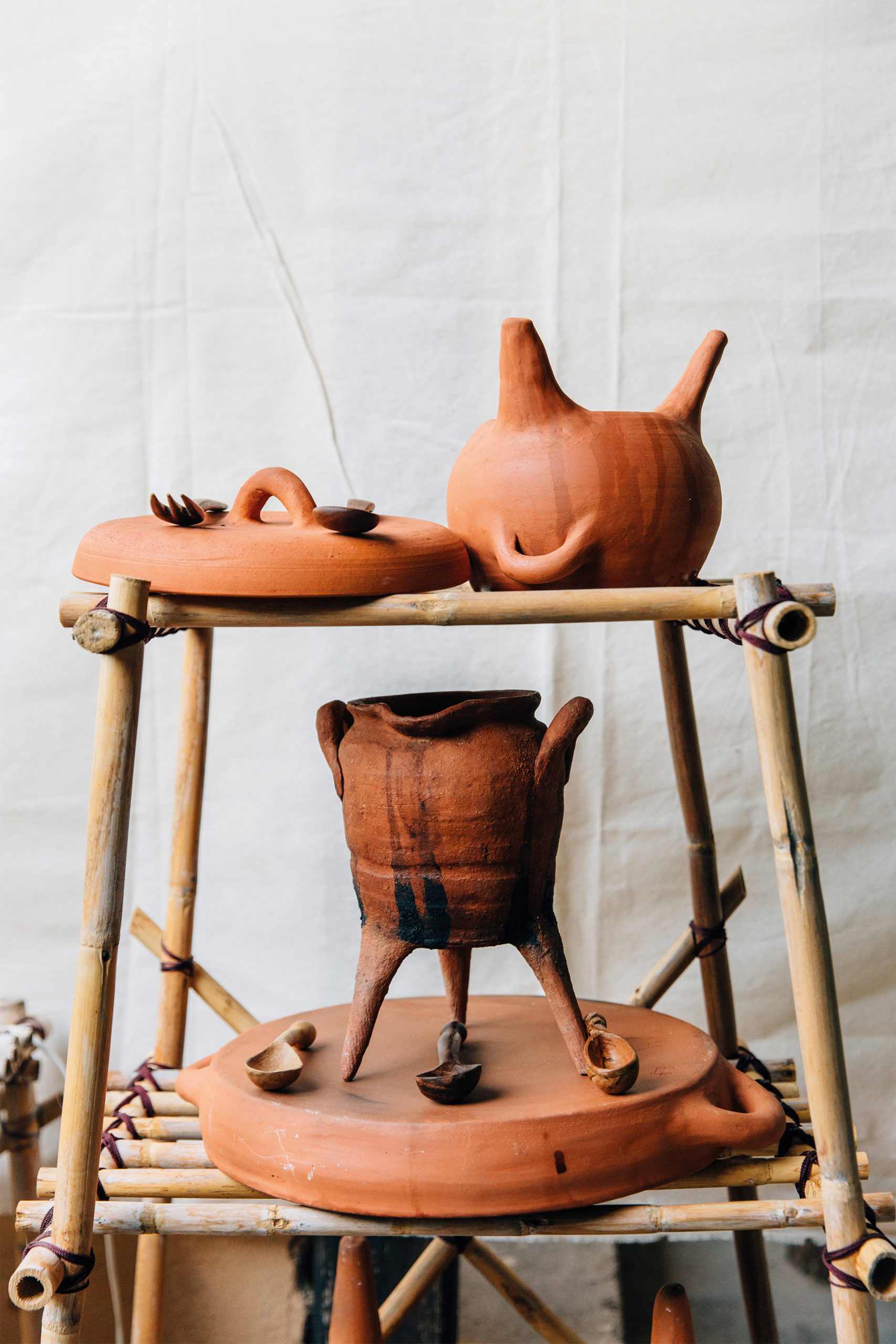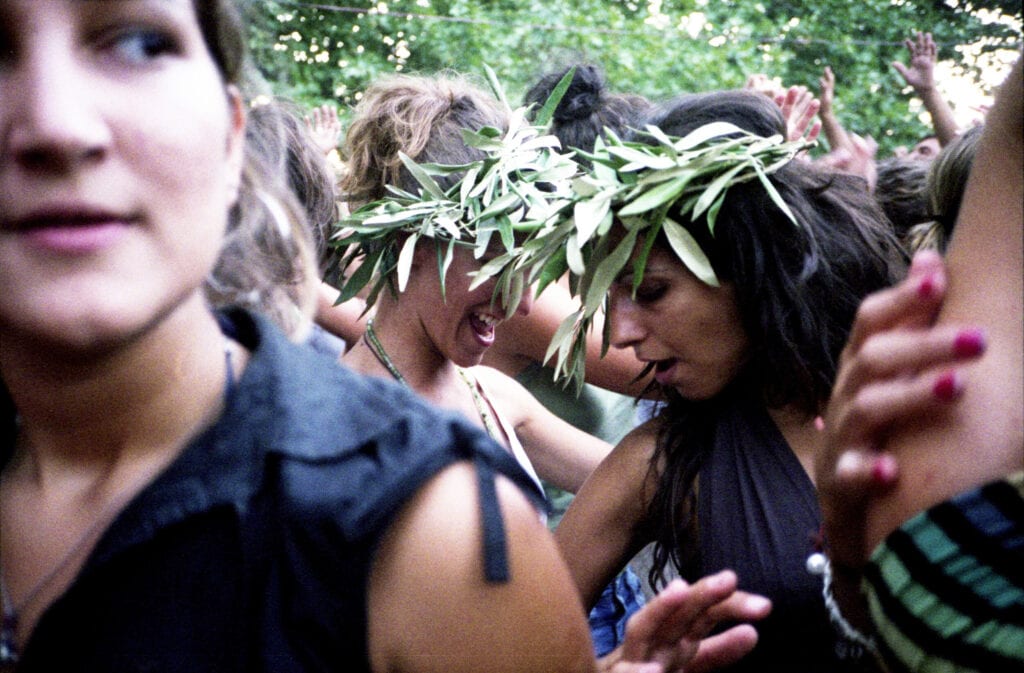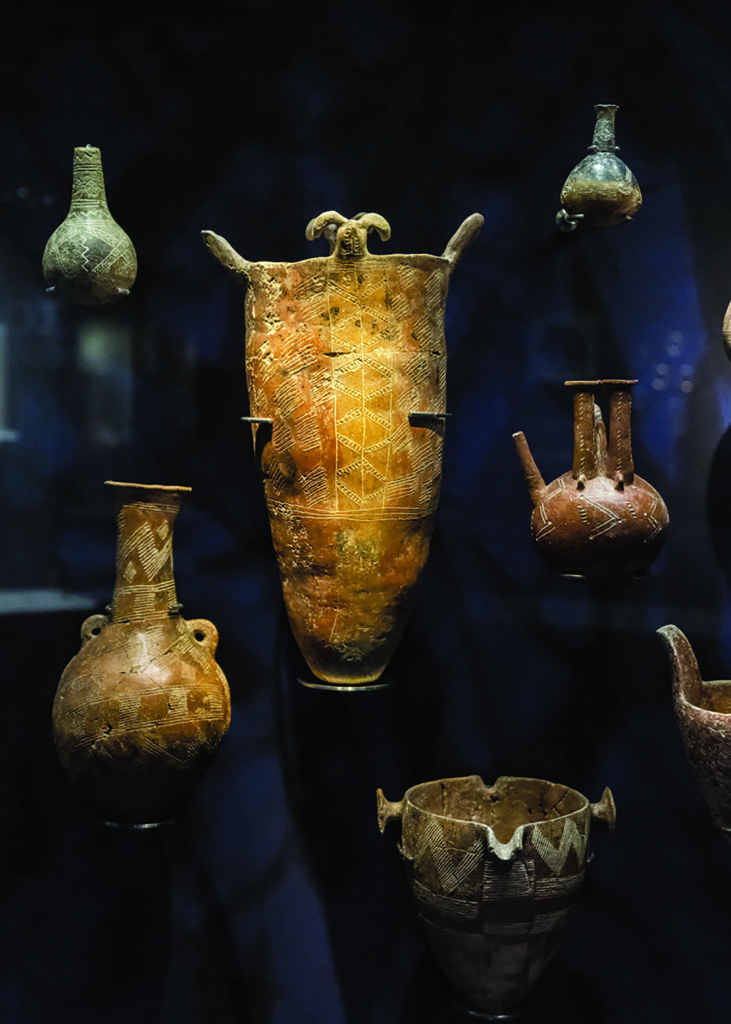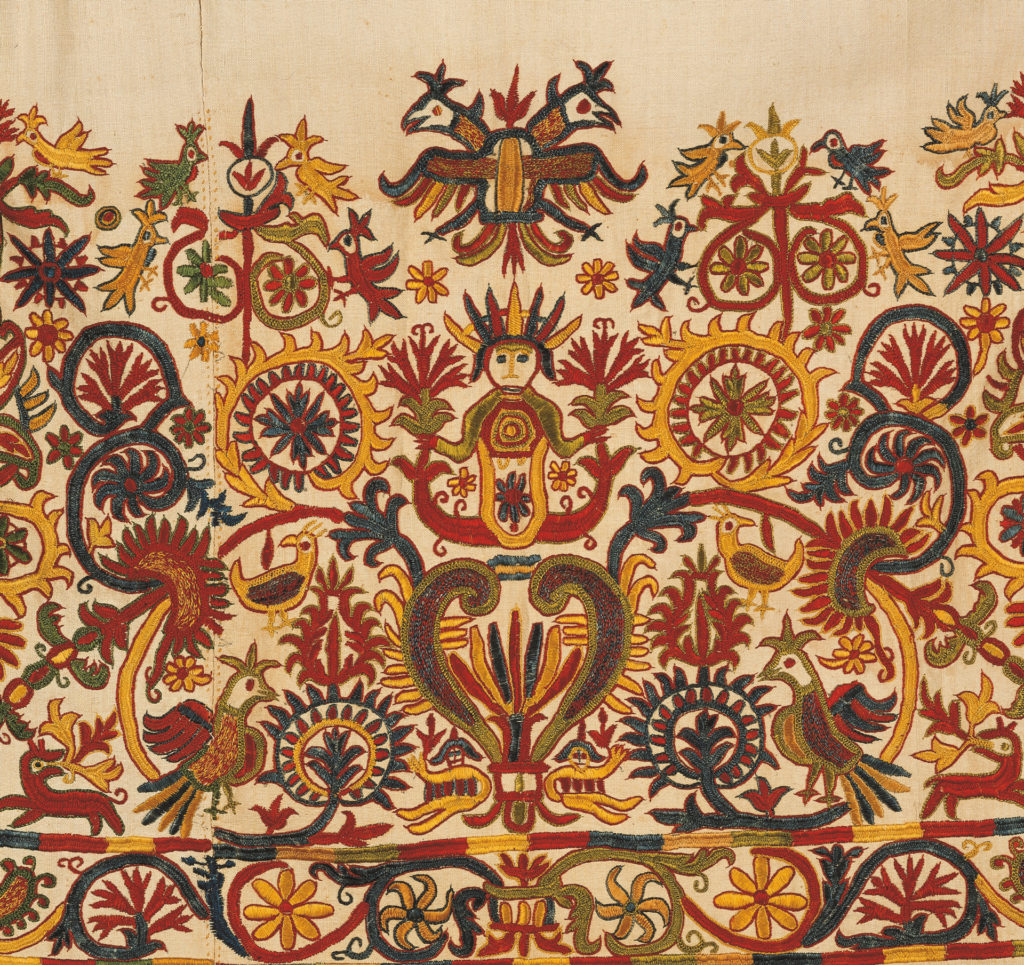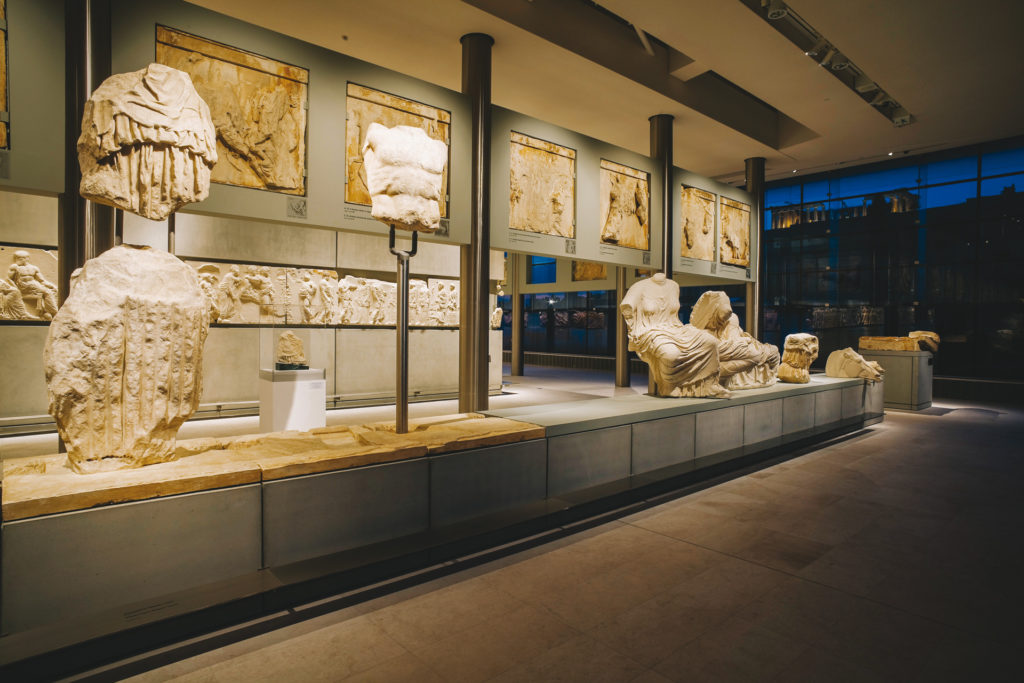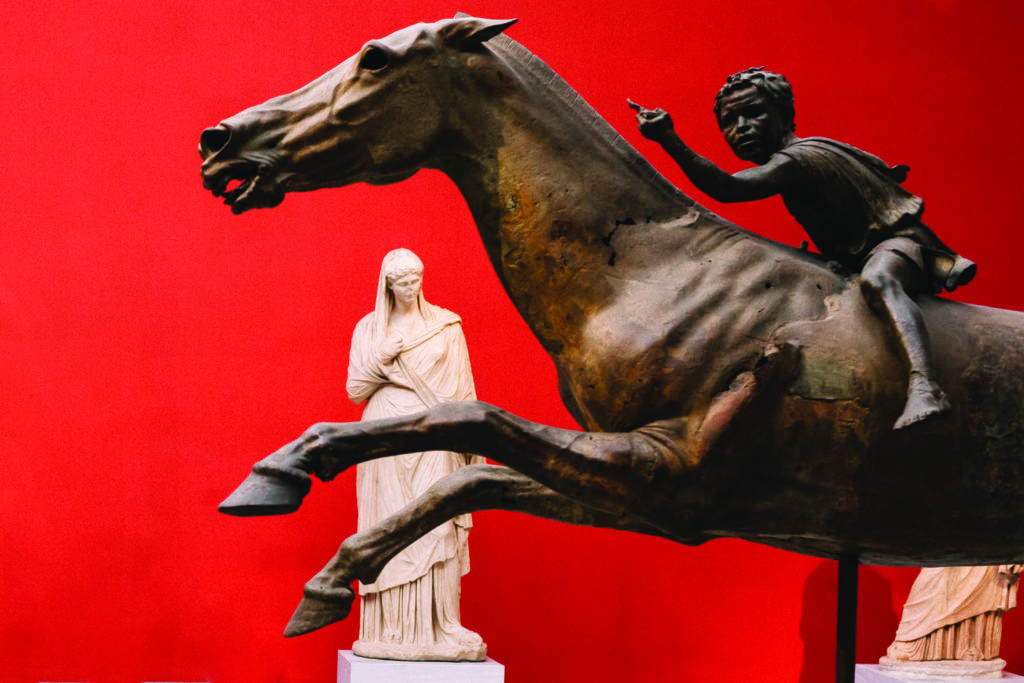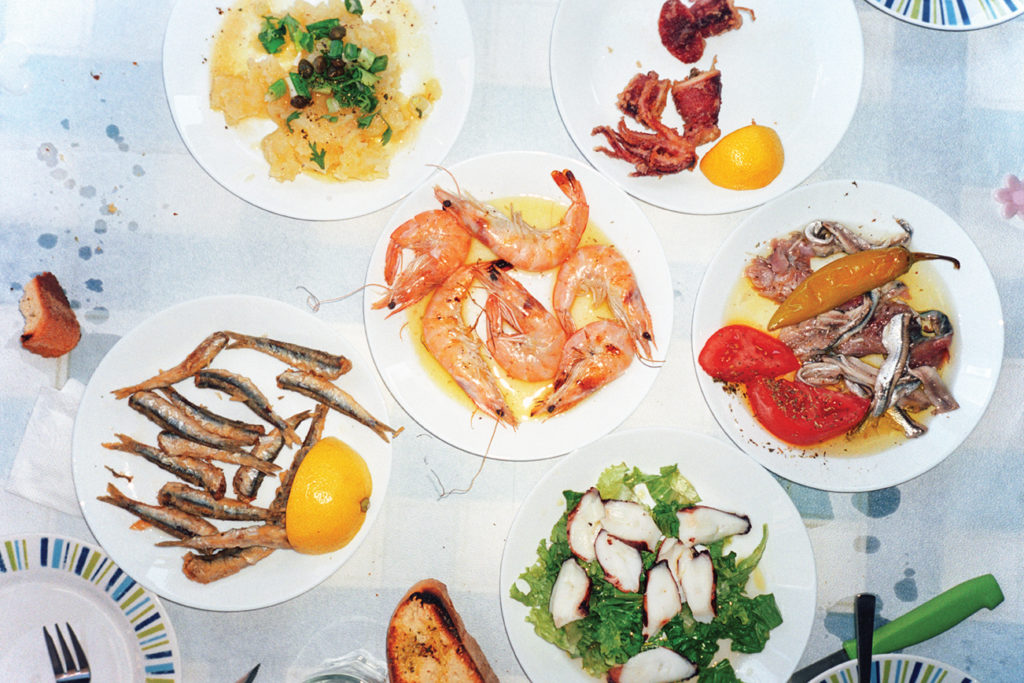The combination of heat and high humidity at the end of summer in Southern Crete may be the ideal condition to spend your time swimming and sunbathing on the beach, but that’s not the case for someone who cooks in open air under the blazing sun. Jerolyn has been making preparations since 7 o’clock in the morning to get everything ready for a feast that will inevitably remind you of an ancient “symposium” (the banquet of ancient Greeks). She lights the fire, preheats the tripods (the Minoan pots used for cooking) by placing coals around their “legs”, cuts the ingredients –meat, onions, leeks, herbs- and puts them in the pots to be cooked. What she does is unique: she creates cooking pots identical to the ancient ones found in excavations on the island, and uses them to cook dishes based on the Minoan diet. Jerolyn Elizabeth Morrisson, an artist and archaeologist tells us her fascinating story.
Coming to crete
I first came to Chania Crete in September of 1997 to visit a dear friend of mine, Jennifer Moody, who later became my mentor and colleague in archaeology. I was in my early 20s and i was interested in documenting different types of craft production. Back then I used to work at the Penland School of Crafts in North Carolina, and I would often travel to Mexico in the winter. It was during one of those trips that the Chiapas rebelled against the government of Mexico, and as the war escalated it became too dangerous for me to stay there. Instead of returning to my base, I decided to visit Jenny in Crete, without knowing much about the island that was meant to have a great impact on me. I ended up spending a month with Jenny learning about the ancient landscape of the island. It was through her introduction that I had the chance to get to know and love Crete. I have been studying and living on the island ever since.
After ten seasons of working in Chania and Rethymnon in western Crete and in the Mesara plain in south-central Crete, I was awarded an internship to study petrography at a nonprofit institution in eastern Crete located near Ierapetra. With the completion of the internship, I went to work on the Minoan and Hellenistic archaeological site at Mochlos on the northeastern coast of Crete. The Late Bronze Age pottery from the site became the focus of my PhD studies on Minoan cooking. While there are beautiful villages around this area, I enjoy the activities of a city, so I chose to live in Ierapetra since I find the history of the city intriguing. It is located on the tropical southeastern coast of Crete, which faces south toward Libya and Egypt.
In antiquity Ierapetra was a potent port city with its own coinage. Walking around the city, its history becomes obvious through its ancient Egyptian marble columns placed in the extremities of the town, the sections of the Roman-Byzantine wall that stand near one of its many theaters on the western end of the town, its prominent fort and mosque with its fountain, and the street layout and architecture of the old town. Today, Ierapetra has regained its status as a major economic force by being a primary producer of greenhouse vegetables, among which tomatoes and cucumbers. Tons of high quality vegetables are grown and shipped northward to the rest of Greece and throughout Europe. Ierapetra is an easy going place to live in with interesting people and beautiful sceneries. I always thought I would work in western Crete, but in the end it was Ierapetra that charmed me the most. One can never predict the future after all.
I find my connection to food to be somewhat primal, and I enjoy the whole procedure; the shopping, the preparations, the cooking, and of course eating! Beyond the pleasures that food can bring to your senses, it also offers a way to connect with people and through it learn about different cultures and places. It is my strong belief that food is a human right and a powerful medium for communication.
The reason I became so attracted to the ancient food of Greece lies in the very fact that culinary habits is one solid way to learn more about the daily life of the people of a place. More than often, in the archaeological environment, scholars may raise larger questions about trade, war, and religion, and the stories of everyday life are pushed into the background. This is changing! More and more scholars are interested in how ancient people lived, and this is very exciting.
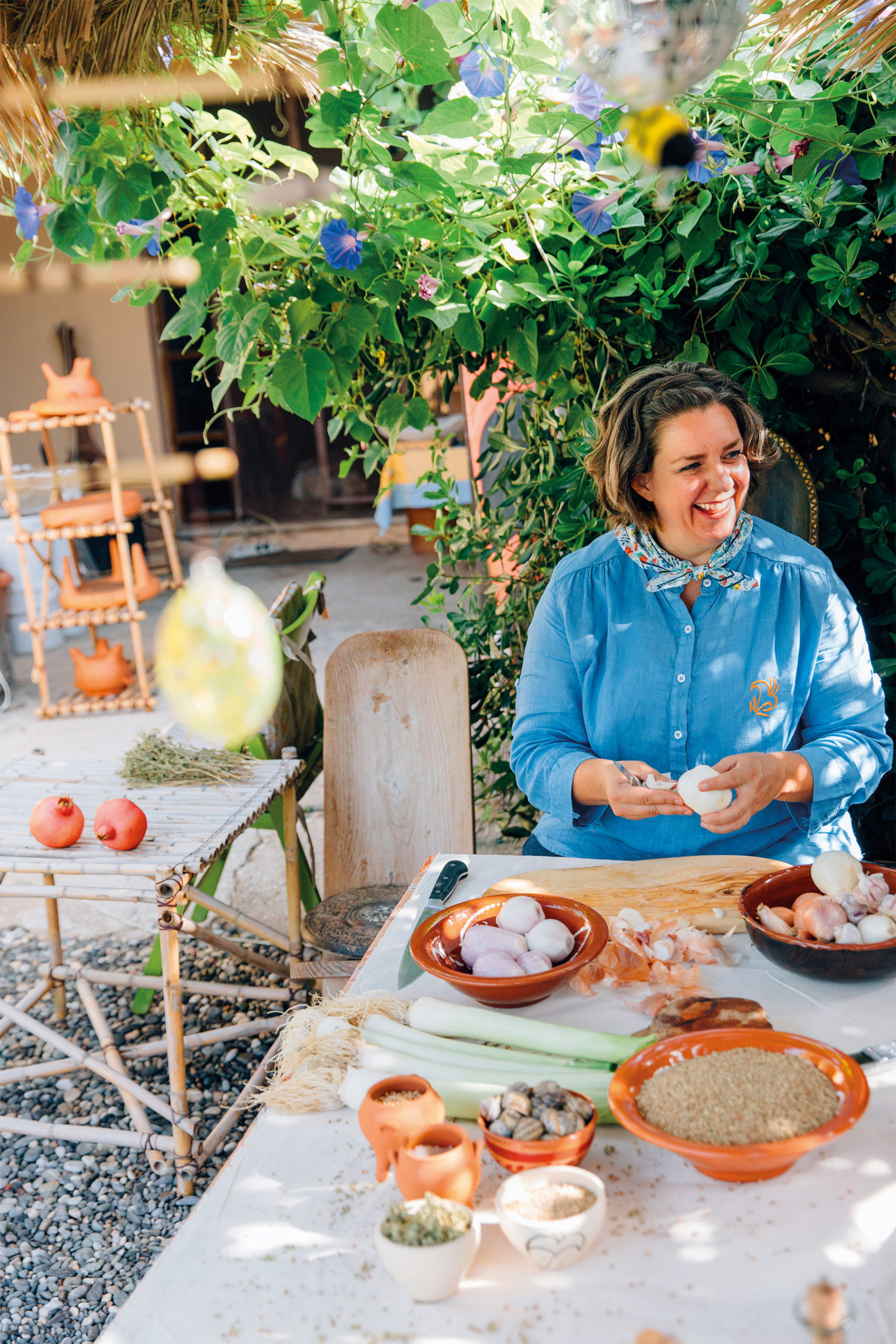
Jerolyn Elisabeth Morisson at her home in Ierapetra
Minoan cooking pots
Ancient cooking is often highlighted in the archaeological museums of Crete. It is exciting to see these everyday objects available for people to discover. I am most familiar with the museums in the Lasithi prefecture at Sitia and Agios Nikolaos because many of the pots I’ve been studying are housed in the museums of these regions. In the Sitia museum, for example, one can see a variety of Minoan tripod cooking pots and jars, ceramic grills with pig bones, and cooking dishes with limpet shells, all excavated from archeological sites in Mochlos, Palaikastro, and Papadiokambos. Minoan cooking pots are also on display in the archaeological museums of Herakleion, Chania, and Rethymnon.
I started using earthenware clay when I was an undergraduate in Texas. It was the cheapest and most forgiving of all the clays in the studio. I adored it. Each semester we mixed our own clays, and I would create a clay body that was full of inclusions that fired up a deep red color. Concluding my university studies, I attended the Penland School of Crafts in North Carolina for four years, where I learned to work with raw, red, and coarse clay from the Appalachian Mountains. The studio offered several kilns powered by a variety of fuels (wood, natural gas, and electric) and in each one of them the raw clay came out with a different appearance and texture. As far as making ceramic cooking pots the way I do today, this adventure did not start until 2007. In the ten years that have passed since then I’ve learnt a lot, and I’m still learning.
Time, practice, imagination, and dedication are what is needed to make the perfect cooking pot. The big-bellied Minoan-style tripod pot does not have a complicated form, but when you use these cooking vessels multiple times a week you realize how the details of the design affect the way it is handled for cooking. For example, the wall thickness, the way the handles and legs are attached, as well as the width of the mouth and shape of the rim, especially in its relationship to the lid, will impact how the vessel performs while you use it for cooking. The subtle differences in how these design elements are combined will surely have an impact on one’s preference for a specific cooking pot among a collection of vessels that in general look the same. For example, when I am slow roasting hare or rabbit on the bone, I like to use a pot with a slightly wider mouth so I can more easily, and gently, turn the meat preventing it from falling off the bone. Whereas when I prepare certain types of seafood, like octopus or cuttlefish, or even legumes, I like to use a pot that has a narrower mouth because it keeps most of the moisture inside.
What I attempt to do though, is to interpret the Minoan Tastes by combining a variety of methods in order to compile a list of foods that may have been available during that period of time on the island. I call it the “Minoan Grocery Store List.”
Just to be clear, these are my own cooking habits concerning the use of the Minoan-style ceramic cooking pots, and not a thesis on the cooking habits of the people who lived during the Minoan period. This project on the Minoan cooking is multifaceted, and there is a difference between my personal preferences when working with an object and my interpretation on a matter as an archaeologist about the past. The truth is, there is still much to be discovered about the process of the production of ancient pots and the way they were used for cooking, and even if there are methods in archeological experimentation that will help reveal hidden aspects of ancient people’s everyday life, archaeologists cannot use them to tell you what ancient people did or did not like.
I myself wanted to create cooking pots using similar clays to the ones used by the Minoan potters at Mochlos. Our archaeological team has found evidence of a pottery workshop, but we only have a general idea on where the clays can be found, because it has been over 3,000 years since Minoan potters used to make cooking pots at Mochlos. So it goes without saying that finding the exact location where they collected the clay to make pots is just not realistic! In order to make my own cooking pots, I began by collecting red and purple clays that were full of rocks from the phyllite-quartzite series in eastern Crete because geologically, these clays match the ancient cooking pots. The next step was to clean the clays by removing the unwanted leaves, twigs, and larger rocks, which otherwise would make it impossible for me to produce a vessel. Finally, I would test if the clay could be used to create a pot just by using my own two hands by forming small cups. Surprisingly, even though the clays looked the same they could not all be used! I collected a large amount of those clays that had the best plasticity, meaning that they could be formed into a solid shape. Then I would clean the clays and stored them in ceramic pithoi (large jars) with water for several months to fully hydrate them. I collected two clays to work on, red and purple.
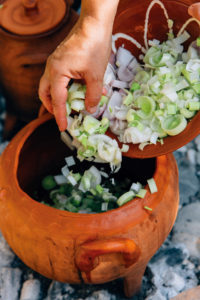
Adding the ingredients in the clay pots.
When the clay was ready, I extracted what I needed and began to learn how to make Minoan-style cooking pots. I used a kick wheel, similar to the ancient potter’s wheel, that could be operated manually. This is an important detail because while potters are making a vase they contemporaneously have to keep in mind the type of clay, the form of the pot to be created, and the speed of the wheel. It is a perfectly balancing act! Learning to use your tools correctly is an important part of learning to work with different types of clay, especially when it is difficult to make a form. It took me many weeks to learn how to make a cooking pot that was 6 to 8 liters in volume. Even though the purple clay was easily molded making it easy for me to shape, it would as easily collapse too.
The red clay on the other hand was quite brittle and it cracked each time I tried to form it into a vessel shape. Eventually I learned that the only way to make a cooking pot from the Mochlos’ clay was to use a technique called coil-and-wheel. This ancient technique combines both coiling (hand building) and shaping the pots on the wheel. It is a common technique used even today by many potters in Thrapsano, Crete, to make large storage jars (pithoi). When you examine the ancient cooking pots from Mochlos, the coils are difficult to see because the potters used to smooth the outer surface of the clay, but on the inside there are some concentric creases created by the wheel. I have examined hundreds of Minoan cooking pots, and only one artifact from Mochlos has a coil join that is visible at the break near the base of the vessel. Due to the way the clay from Mochlos village reacts when used to make pots, I came to the conclusion that the ancient potters had to use a coil-and-wheel method to create both medium and large pots. However, since Crete is a big and quite complexed island, one must keep in mind that there are many different types of clays and artisans who work with it. It is possible that in another region of Crete potters used clays with different properties that required different forming techniques, or they simply learned to make pots using different skill sets.
The entire process, from finding the clay source that was similar to the one that the Minoan potters used at Mochlos, to making a cooking pot in which I could cooked, took me roughly one year.
Cooking in the pots
I use my own Minoan-style ceramic cooking pots to prepare food over a hearth fire. Cooking in the big-bellied tripod cooking pots can take three to five hours to prepare a dish. This type of cooking requires concentration and discipline; after all, food is something one must take seriously. It needs to be checked at the right time and additional ingredients must be added, and you must not open the lid unless it is absolutely needed. Every time the lid is open, the pot loses heat and the process of cooking slows down. This can be frustrating, because if you are cooking outside and the weather is windy, humid, or cold it will take more time, fuel, and effort to build up the heat all over again.
Cooking like that is a special process that teaches you how to relax and let the time and the heat do the job. The most important thing to do, once the food is in the pot, is to tend to the fire. One must know how to adjust the temperature, as well as to be aware of which parts of the pot are heated just like when firing a wood kiln. So, it is equally important to control the fire, ensuring that everything will proceed as it should, and at the same time understand exactly how the vessel responds to heat in order not to break, allowing at the same time, the ingredients to be cooked properly. I would say that in some way, the whole procedure is magical.
I have used all three types of Minoan-style cooking pots to prepare food. Tripod cooking pots and jars are closed vessels and they work really well for slow roasting or stewing meats, legumes, and octopus or cuttlefish. The trays and cooking dishes are open vessels and they are ideal for sautéing, grilling, and baking delicate foods like snails, mushrooms, fish, quail, different cuts of meat such as pancetta, and pita bread.
Until today, archeologists haven’t discovered any ancient written Minoan recipes, so I need to stress that what I cook cannot be defined as ancient Minoan cooking. What I attempt to do though, is to interpret the Minoan Tastes by combining a variety of methods in order to compile a list of foods that may have been available during that period of time on the island. I call it the “Minoan Grocery Store List.” Substantially, it is an interpretative list of Minoan-like foods derived from four sources: macrobotanical remains (seed and bones) collected on archaeological sites, chemical residue analysis on pots and stone tools, environmental data, as well as iconography and script. Therefore, the aim of the Minoan Tastes program is to explore what it’s like to cook in these particular pots with a limited food list, in order to better understand what it could have been like to prepare food during the Minoan era in Crete. I like to think that it functions as a bridge that could link the past with the present and may serve as a platform for a debate on a variety of topics.
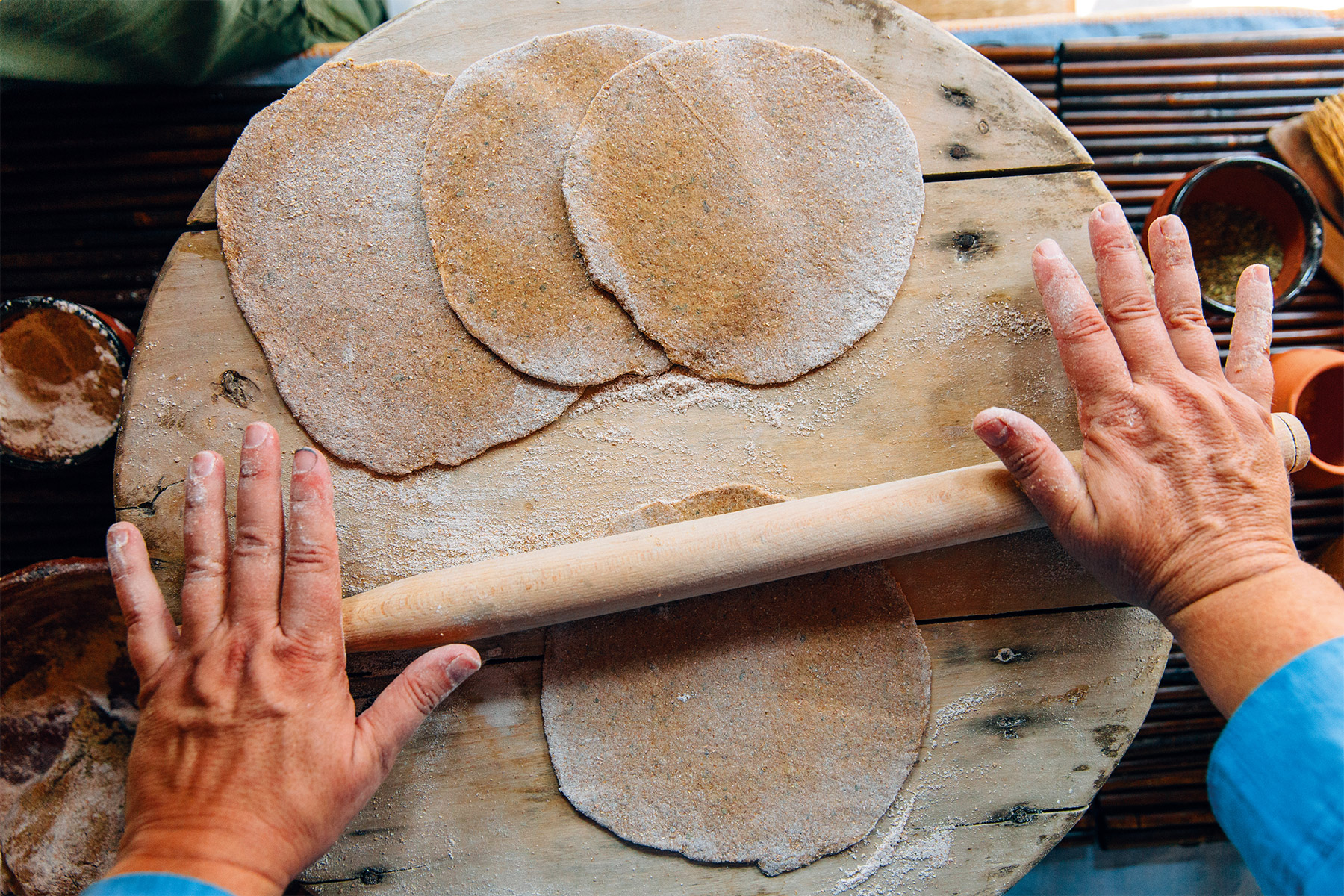
As far as authenticity is concerned, during the Papadiokambos excavations, we have discovered brown lentils inside a tripod cooking pot and limpet shells inside a cooking jar. That’s how I know that the brown lentils and limpets I cooked using these techniques of simmering and sautéing, is most likely authentic. Surely, the way I choose to season what I cook may be different from the way the people of the Minoan era would season it. After all, taste is a personal as well as a cultural matter, and I suspect that the way I season foods using the Minoan Grocery Story List, may be different than the way Minoans would season their food. It is of great importance as well, to point out that there is no direct evidence that would suggest Minoans had a preference for sweet, sour, or salty foods. These are just some of the limitations one will inevitably come across when exploring a prehistoric culture without having any written evidence. Since the aim of the program however, is more than just replicating Minoan food, in the end those limitations are of little importance.
What I am quite impressed with is the variation of the Neopalatial dietary habits across the island through which, it becomes evident that the way humans lead their everyday life is quite often related to the way they get their food. For example, the types of food remains that have been recovered on the island demonstrate that people were farmers and breeders, but they would also go hunting or fishing. The way people come to obtain their food could be almost as exciting as what they choose to eat. What surprised me though, is that according to the same food remains, it appears that people ate more sheep, goat and pork than I was expecting. The lack of human skeletal remains though, makes it very difficult, and at some point even frustrating, to draw any conclusions on how those dietary habits affected the health of the people of the Neopalatial era.
Over the years there has been much information gathered on the shapes and sizes of Minoan cooking pots. At almost all Minoan archeological sites you will find tripod cooking pots, cooking dishes, and cooking trays. There are other cooking accessories too, but these are the main vessel types. Archaeologists have suggested that people used these pots for simmering, roasting, frying, and baking different types of foods. The work that I have developed with experimental pot making and cooking has systematically focused on recreating these vessel types and learning more about the different ways that they can be used for cooking. For example, in the case of the tripod cooking pots and cooking jars, their closed globular shapes are ideal for simmering and roasting foods – particularly legumes and meat. While other types of pots like cooking trays, which are open and shallow would be perfect for cooking techniques such as sautéing, frying, baking bread, making thicker types of sauces or soups, and drying foods.
Ancient and contemporary cooking: a continuity
There are many differences between the Minoan ancient diet and what is considered to be today’s traditional Greek diet. The most obvious one is the total lack of aubergines, tomatoes, zucchini, potatoes, cucumbers, and peppers in the Minoan era diet. Strange as it is, all these ingredients that have been introduced to Greece quite recently, have been present in almost all dishes that are today considered to constitute the authentic Greek cuisine!
Food and cooking in Greece is going through yet another quite disturbing transformation, which is no other than the introduction of processed fast-food. People are becoming overweight and the health problems they develop are becoming an epidemic especially among children. My experience shows me that most people know little about nutrition or, even worse, do not understand how health and dietary habits are related. They think that just because they do not eat at fast food restaurants they will have no health problems related to their dietary habits, which could not be farther from the truth.
Through my experience of living in Crete, I’ve come to understand that people in villages are in the majority of the cases connected with the seasonality of the food. Even with modern day conveniences there is this desire to be connected to nature and what it has to offer depending on the season. For example, almost everyone keeps a small garden, a few olive trees, a plot of grape vines, or at the very least some herbs in pots on their balcony. Many will even go mushroom hunting after the first rain fall. During hunting season most of the men will go hunting and throughout the year women and men will fish or they will go diving. Occasionally, people will also collect land snails or limpets from the sea rocks, as well as wild greens, herbs, and herbal teas throughout the year. Some people still breed sheep or goats to have their own milk or make cheese for their family! People in Crete are sentimental about food and they need to know where it comes from. I think this sentimentality comes from being tied to the island.
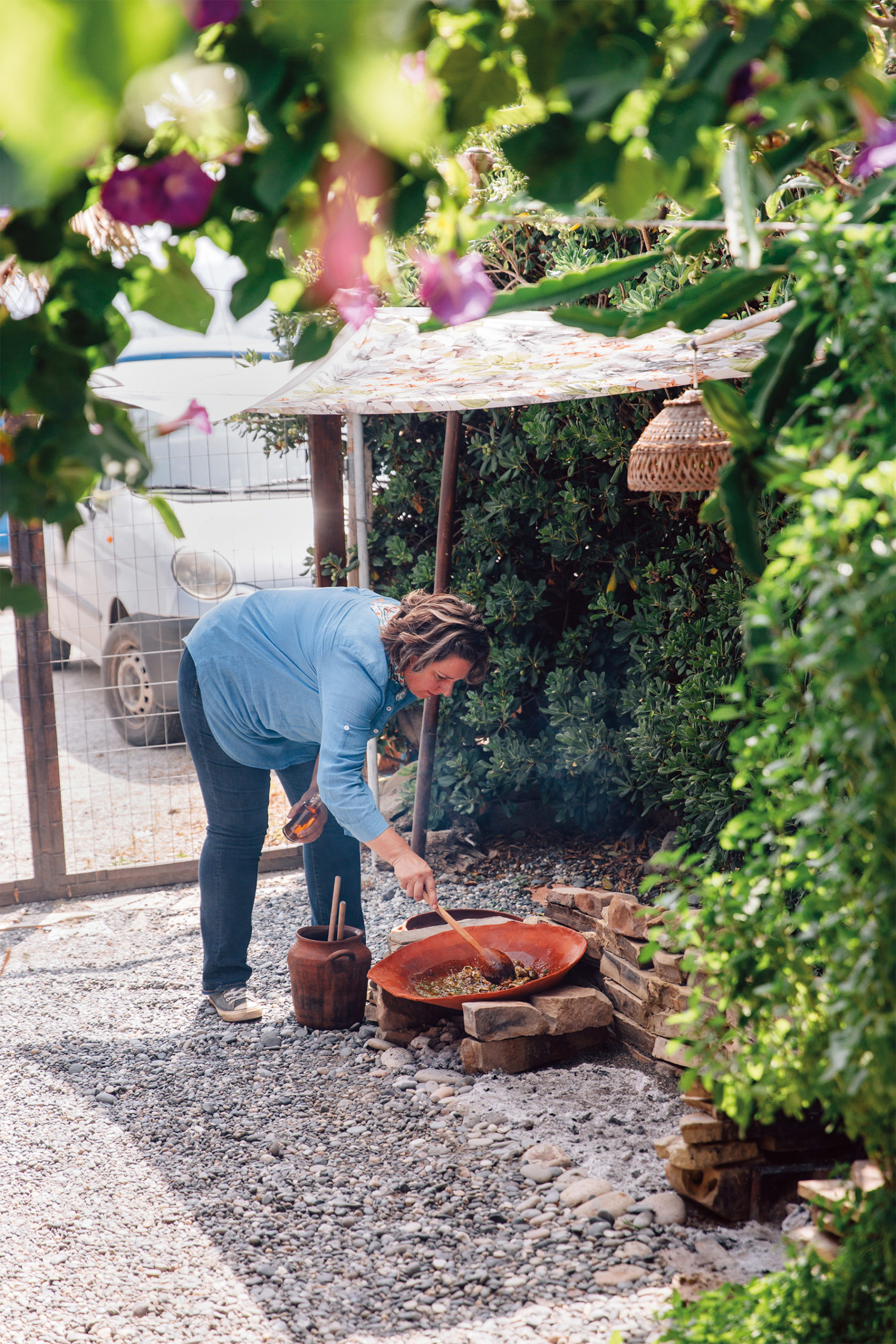
Even if there are differences when it comes to seasoning and preparation of the food, there is a strong continuity concerning the dietary habits of Minoans and modern Cretans. For example, people today eat a lot of brown lentils, fish, pork, and sheep or goat, all of which seem to have been prominent foods in the Minoan diet during the late Minoan era. Furthermore, people in the Minoan era had access to many of the same foods that we eat regularly even today like figs, grapes, almonds, and olives. Surprisingly enough, there is an amazing continuity.
The dishes I prepared today, are foods and ingredients that would have been available during the Late Minoan era, and are based on some older traditional Cretan recipes. When creating a dish I use few ingredients. I like a simple approach, because cooking in the ceramic pots over the hearth fire creates as it is a distinct taste.
Jerolyn Elizabeth Morrisson is an artist and archaeologist with a Bachelor Degree in Fine Arts and Ceramic Arts, a Master in Arts and Anthropology and a PhD in Ancient History and Archaeology.
The dishes she cooked for the feast: Cuttlefish in ink. Brown lentils simmered with coriander and leeks seasoned with honey and topped off with olive oil and sea salt. Lamb off the bone simmered in wine and xinohondros (sour wheat moulded in tepid fermented goat/sheep milk, and then shaped in small round pieces) and wild sage. Snails with vinegar, rosemary and sea salt. Pita with dried Cretan herbs.
www.minoantastes.com

